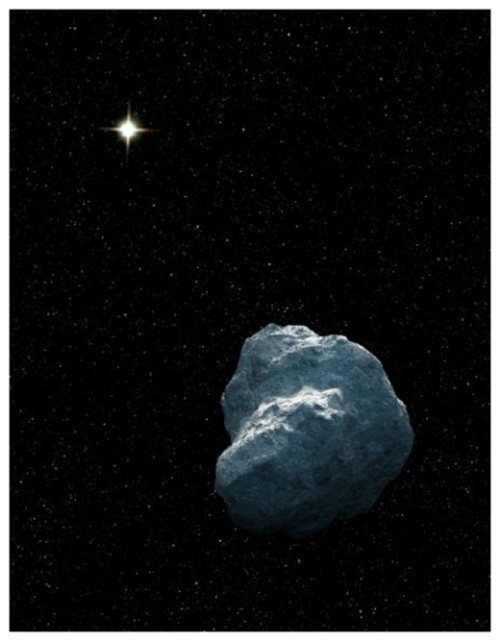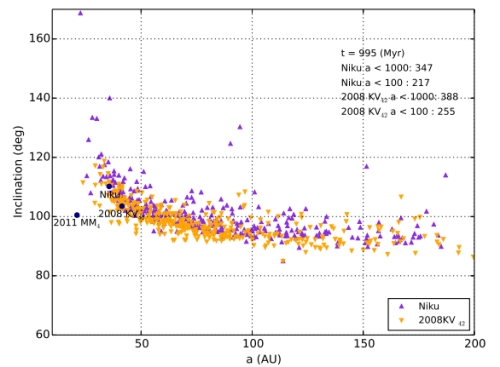We’ve all come to terms with the fact that beyond the orbit of Neptune there exists a large number of objects. These trans-Neptunian objects (TNOs) substantially altered the almost sedate view of the Solar System that prevailed in the first half of the 20th Century, showing us that far from being a tame and orderly place of planets, asteroids and comets, we were in a system filled with material left over the the system’s formation. Tame and orderly became ragged and unkempt, and it was clear that the outer system was a place ripe for discovery.
Pluto was the first TNO to be discovered, all the way back in 1930, but the modern era of trans-Neptunian objects began in 1992 with the discovery of (15760) 1992 QB, and we can now count over 1750 TNOs, as listed by the Minor Planet Center. Bear in mind that we can divide the entire space occupied by TNOs into several prominent divisions: the Kuiper Belt, the Oort Cloud, and the scattered disk, with a few outliers like Sedna causing continuing controversy.

Image: Artist’s impression of a trans-Neptunian object. Credit: © NASA, ESA, and G. Bacon (STScI).
Which gets us to another controversial object, an unusual world its discoverers have named Niku. Probably less than 200 kilometers in diameter, Niku’s outstanding characteristic is that its orbital plane is tilted 110 degrees to the plane of the Solar System. The object is in a retrograde orbit, moving around the Sun in a direction opposite to the rest of the planets. We have one other TNO that fits the retrograde classification: 2008 KV42.
The paper on Niku, produced by Ying-Tung Chen (Academia Sinica, Taipei) and colleagues points out that 2008 KV42 has previously been the subject of dynamical simulations that show its orbit has a lifetime stable for billions of years. The researchers believe the Kuiper Belt is an unlikely origin for such a retrograde object, which may implicate the Oort Cloud, but the orbital dynamics of this population of objects await a good deal of further work.
Discovered as part of the Panoramic Survey Telescope and Rapid Response System 1 Survey (Pan-STARRS 1) in Hawaii, Niku is another indication that something is preserving the orbits of these objects. The team’s simulations — using 1000 clones and moving them forward for a period of one billion years — show stable orbits matching the location of Niku and 2008 KV42, hence indicating the possibility of a large population with similar origins.

Image: The orbital distribution of survivors from 1000 initial clones of Niku (purple) and 2008 KV42 (orange) after 1 Gyr approximately. The overall clones decay far more slowly than normal Centaurs, with > 30% of the test particles remaining dynamical stability at the end of a 1 Gyr integration. Note that the orbits of Niku and 2008 KV42 are located at the highest density position in this plot. Credit: Chen et al.
What would cause clustering in the orbits of known objects with highly inclined orbits? To make sense of it, the team turned to known high-inclination objects from the Minor Planet Center catalog, selecting them according to criteria drawn loosely from their simulations. We have a small number of samples — the team was working with only six objects. Even so, the probability of getting six objects into a common plane is low enough to argue against coincidence. And because orbital precession should prevent long-term clustering, the authors assume that another mechanism has to explain it. Planet Nine immediately comes to mind, the hypothesized world that may lurk in the Solar System’s outer reaches. Evidence for Planet Nine, after all, comes from a similar group of objects in highly inclined orbits.
But a hypothetical Planet Nine, an undiscovered dwarf planet in the scattered disk, and a distant solar companion all fail when subjected to the team’s analysis. To explain the observed clustering requires some kind of mechanism that remains undiscovered. In the quotation from the paper below, ? refers to the longitude of the ascending node, one of the orbital elements used to specify key orbital parameters. It is here that the clustering is observed:
…we established through numerical integrations that the putative Planet Nine was unable to explain the orbital confinement. In addition, we also attempted more extreme alternative scenarios, consisting of integrations that include a synthetic high-inclination dwarf planet of a few Earth masses whose orbit crosses the giant planet region. None of these attempts succeeded in anchoring the ? of the test particles. Moreover, adding a planet into planet-crossing region has a very high chance of disrupting the orbital structure of the Kuiper Belt and remaining outer Solar System.
Niku’s orbit is a mystery — no wonder its name means ‘rebellious’ in Chinese. We could use a lot more data on objects like Niku to help us understand their apparently long-lived orbital plane and the factors that keep it stable. The authors point to projects like the upcoming Large Synoptic Survey Telescope (LSST) survey that will perform a ten-year scan producing a 200 petabyte set of images beginning in 2022. We can hope the LSST survey will uncover whatever object or objects are responsible for sculpting the orbits of these high-inclination TNOs.
The paper is Ying-Tung Chen et al., “Discovery of A New Retrograde Trans-Neptunian Object: Hint of A Common Orbital Plane for Low Semi-Major Axis, High Inclination TNOs and Centaurs,” accepted at Astrophysical Journal Letters (preprint).



Perhaps Niku is part of a family of icy bodies that were thrown out by a close encounter with one of the larger planets.
Has anyone heard more about the gossip of a big announcement coming out at the end of the month? Apparently an earth-like planet has been found in the habitable zone of Proxima Centauri. Since this site is named Centauri Dreams, I thought you would like to look into this. (The article is on today’s spacedaily.)
The Proxima Centauri story is now getting a lot of circulation. As I said before, I don’t cover stories on evident embargo breaks because they often contain misleading information. What I can say is that when data are publicly released on any Proxima findings, I’ll be talking about them here. The schedule for that is unknown to me.
For those wanting to talk about this, the thread on the post “SETI, Astrobiology and Red Dwarfs” will be the place to go:
https://centauri-dreams.org/?p=36090
That way we can keep the thread here on topic.
Sol isn’t the only planetary system with belts made of planetoids and comets:
http://phys.org/news/2016-08-planetesimal-belt-hr8799.html
“Niku’s outstanding characteristic is that its orbital plane is tilted 110 degrees to the plane of the Solar System. What’s more, this object is in a retrograde orbit, moving around the Sun in a direction opposite to the rest of the planets. ”
That’s redundant. If inclination is greater than 90º, orbit is retrograde.
Good point. Now fixed.
Niku hints at a more complicated Trans-Neptunian region than hitherto imagined. Though I read the preprint as implying the need for another hefty object out there, just smaller than Planet Nine. The suggestion of *two* additional planets, at 213 AU and 329 AU, might have some relevance. Would be interesting to see the population simulations run with those thrown in the mix.
Newbie question: Wouldn’t orbital dynamics alone create an energy plateau at an inclination of 90 degrees to the primary disk? So an object that by happenstance started orbiting at close to 90 degrees inclination might tend stay there instead of collapsing to zero. An object that starts out in a more inclined orbit (e.g. 30 degrees) would more easily fall to the zero plane and in so doing pick up speed, and just settle into a larger orbit due to its increase in speed. Whereas an object orbiting at 90 degrees would feel more or less equal pulls toward inclinations of greater or less than 90 degrees, so would tend to stay balanced at 90. If this is true, many orbital systems should retain a small remnant of members orbiting at close to 90 degrees inclination.
Could Gaia discover more TNOs of this kind?
Jonny: But why would an object START OUT with a 90 degree inclination? All solar system objects are thought to originate from a thin disk of material orbiting the proto-sun. So anything that deviates from that original disk plane must have had its orbit altered subsequent to formation?
I don’t know, and leave it to the astrophysicists to speculate more authoritatively. My speculation is not that well informed, but it seems possible that if the solar system is a condensed remnant of a supernova, there would have been some debris in the neighborhood that was not orbiting in the disk plane, either because it got knocked out during or after the supernova or because it was passing by and fell into the gravity well of the disk. After all, there are plenty of nebulae that are not generally disk shaped, from which stars are thought to condense. If the thin disk evolved from a vortex of an energetic debris cloud expelled from a supernova, so much the more opportunity for random bits of off-axis debris to be flying around far from the disk center of mass.
Two other articles on Niku, for reference:
http://www.americaspace.com/?p=94829
and…
http://www.universetoday.com/130324/beyond-neptune-chunk-ice-orbiting-sun-wrong-direction/
Maybe SETI should check it for signals.
What effect would a remnant of Sol’s twin (if our system was originally a binary system) have on orbits of planets and TNOs? Could this inclined plane be the plane in which the twin orbits Sol?
August 31, 2016
New Horizons Spies a Kuiper Belt Companion
NASA’s New Horizons is doing some sightseeing along the way, as the spacecraft speeds toward a New Year’s Day 2019 date with an ancient object in the distant region beyond Pluto known as 2014 MU69.
New Horizons recently observed the Kuiper Belt object Quaoar (“Kwa-war”), which – at 690 miles or 1,100 kilometers in diameter – is roughly half the size of Pluto. This animated sequence shows composite images taken by New Horizons’ Long Range Reconnaissance Imager (LORRI) at four different times over July 13-14: “A” on July 13 at 02:00 Universal Time; “B” on July 13 at 04:08 UT; “C” on July 14 at 00:06 UT; and “D” on July 14 at 02:18 UT. Each composite includes 24 individual LORRI images, providing a total exposure time of 239 seconds and making the faint object easier to see.
Full article here:
http://pluto.jhuapl.edu/News-Center/News-Article.php?page=20160831-2